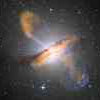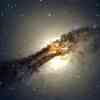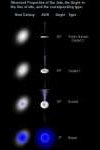Centaurus A is a lenticular radio galaxy approximately four Mpc away (13 million light-years) making it one of the closest active galaxies to the Earth. Observations in infra-red and radio wave lengths have identified jets of material emanating from the core perpendicular to the dust lanes shown in the first photograph. Close to the galaxy, the jets are moving at around half the speed of light. The cause is almost certainly a supermassive black hole of about 100 million solar masses at the center of the galaxy. Image Credit
Centaurus A is the result of a merger of an elliptical with a spiral galaxy; probably a barred-spiral like the Milky Way as analysis has identified the faint remains of the central bar. This has triggered huge new star formation, with over 100 star forming regions identified to date. You can see many massive, bright blue stars to the right edge, and near the lower left in the center picture of the galaxy. Image Credit
The parallelogram shape in the lower picture is the remnant of the small spiral galaxy that merged between 200 and 700 million years ago. The image was taken in the near-infrared to highlight this feature which is not visible in the main picture. Image Credit
Centaurus A is the result of a merger of an elliptical with a spiral galaxy; probably a barred-spiral like the Milky Way as analysis has identified the faint remains of the central bar. This has triggered huge new star formation, with over 100 star forming regions identified to date. You can see many massive, bright blue stars to the right edge, and near the lower left in the center picture of the galaxy. Image Credit
The parallelogram shape in the lower picture is the remnant of the small spiral galaxy that merged between 200 and 700 million years ago. The image was taken in the near-infrared to highlight this feature which is not visible in the main picture. Image Credit
AGNs include a range of more exotic objects from Seyfert Galaxies to Quasars and Blazars. All are similar in that they are believed to be powered by the infalling of gas, dust and other material from an accretion disk orbiting an active supermassive black hole at the center of a galaxy, which is a very efficient energy generator. Many of these are 100 time the luminosity of the entire Milky Way or more. In fact up to 10% of the mass of an in-falling object gets converted into energy compared to 0.7% for the energy produced in stars like the Sun. Once the quasar has consumed all the available gas, this vast energy production ceases. In fact, the accepted theory is that virtually all galaxies go through an active, quasar-like, stage early on, and then become quiescent as they age. Certainly, there is strong evidence for a massive black hole at the center of the Milky Way, and in our near neighbors the Andromeda and Triangulum galaxies.
The central, active region is generally small, often smaller than the size of our Solar System. In some examples found, jets of material are ejected from the AGN far out into space. The method of ejection, and indeed the material being ejected, is not yet known, although there are a number of theories. It is thought that the different types of AGN are all the same basic object, but viewed from different angles, so the jets could point directly at us, or at 90° to us, or any angle in between; see diagram to the right.
The most distant quasar found (known by the catchy name CFHQS J2329-0301) is at a red-shift of 6.43, corresponding to about 8.6 Gpc (Hubble Constant = 71). We are seeing it as it was when the Universe was only a little over 1 billion years old. Note that IOK-1 is the most distant galaxy known at a redshift of 6.96, corresponding to just 750 million years after the Big Bang. OJ 287 is a BL Lac object, a type of Blazar, that is thought to contain the largest known central supermassive black hole with a mass of approximately 18 billion solar masses. This is more than six times the size of the next largest known black hole. It is probably a binary with a smaller black hole, of around 100 million solar masses, orbiting the larger one every 11 to 12 years. OJ 287 is more than 1 Gpc away, and astronomers estimate that the two black holes will merge in the next 10,000 years or so. As a comparison, the supermassive black hole at the center of the Milky Way is estimated to be 4.1 million solar masses.
The central, active region is generally small, often smaller than the size of our Solar System. In some examples found, jets of material are ejected from the AGN far out into space. The method of ejection, and indeed the material being ejected, is not yet known, although there are a number of theories. It is thought that the different types of AGN are all the same basic object, but viewed from different angles, so the jets could point directly at us, or at 90° to us, or any angle in between; see diagram to the right.
The most distant quasar found (known by the catchy name CFHQS J2329-0301) is at a red-shift of 6.43, corresponding to about 8.6 Gpc (Hubble Constant = 71). We are seeing it as it was when the Universe was only a little over 1 billion years old. Note that IOK-1 is the most distant galaxy known at a redshift of 6.96, corresponding to just 750 million years after the Big Bang. OJ 287 is a BL Lac object, a type of Blazar, that is thought to contain the largest known central supermassive black hole with a mass of approximately 18 billion solar masses. This is more than six times the size of the next largest known black hole. It is probably a binary with a smaller black hole, of around 100 million solar masses, orbiting the larger one every 11 to 12 years. OJ 287 is more than 1 Gpc away, and astronomers estimate that the two black holes will merge in the next 10,000 years or so. As a comparison, the supermassive black hole at the center of the Milky Way is estimated to be 4.1 million solar masses.
Active Galaxies
Centaurus A Galaxy
PKS 1127-145 Quasar
PKS 1127-145 is a quasar more than 3 Gpc, about 10 billion light-years, away. The first image of the pair on the right is from the Hubble Space Telescope, and shows PKS 1127-145, with several other normal galaxies, in visible light. The quasar is the very bright object lower right. The second image is from the Chandra X-Ray Observatory of the same section of the sky. The other objects are not bright in x-rays so are not visible. The Quasar, however, stands out as it emits so much x-ray energy. The jet emerging from the quasar, and seen going up and to the left is nearly a million light-years long. The jet is thought to be the result of the collision of a beam of high-energy electrons with microwaves due to matter in an accretion disk swirling around the central supermassive black hole. X-Ray intensity falls off with distance from the central quasar. Radio emission, however, is strongest from the two "knots" further along the jet. This implies that the jet may be intermittent, with "on" durations of about 100,000 years.
3C 454.3 Blazar
3C 454.3 is a quasar/blazar about 2.17 Gpc, about 7.1 billion light-years, away. Periodically, it undergoes a flaring episode that makes it especially bright, particularly in the gamma-ray part of the spectrum. This image to the right shows the all-sky view from the Fermi Gamma-ray Space Telescope (formerly known as GLAST). It shows areas of bright gamma-ray emission including 3C 454.3, the plane of the Milky Way across the center, and several pulsars. In early December 2009, it was the brightest individual gamma ray source in the sky; twice as bright as the Vela Pulsar, normally the brightest source, which is only about 1,000 light years away. It is also flaring in radio and visible wavelengths, but less dramatically. One of the two jets is pointed almost directly at us which is why it preceived to be so bright. The Geminga Pulsar is around 815 light years away, and the crab is about 6,500 light years away, which makes the brightness of the Blazar at 7.1 billion light years even more spectacular.







